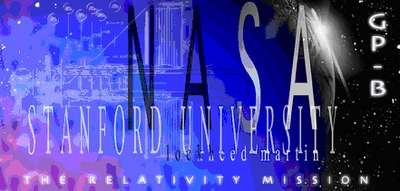Sat, Jul 12, 2003
Gravity Probe B To Test Effect Of Large Spatial Objects On
Space, Time
The NASA spacecraft designed to test two important predictions
included in Albert Einstein's Theory of General Relativity, headed
from the Lockheed Martin Space Systems Facility in Sunnyvale (CA)
to the launch site at Vandenberg Air Force Base, after completing
environmental testing.
NASA's Gravity Probe B mission, also known as GP-B, will use
four ultra-precise gyroscopes to test Einstein's theory that space
and time are distorted by the presence of massive objects. To
accomplish this, the mission will measure two factors -- how space
and time are warped by the presence of the Earth, and how the
Earth's rotation drags space-time around with it.
Stanford University in Stanford (CA) and Lockheed Martin
performed the testing. Shipped by road transport, the vehicle
arrived July 10 at Vandenberg for pre-launch operations in
anticipation of liftoff later this year.

Was Einstein Right?
NASA's Marshall Space Flight Center in Huntsville (AL) manages
the GP-B program. NASA's prime contractor for the mission, Stanford
University, conceived the experiment and is responsible for the
design and integration of the science instrument, as well as for
mission operations and data analysis. Lockheed Martin, a major
subcontractor, designed, integrated and tested the spacecraft and
some of its major payload components.
The erection of the Boeing Delta II launch vehicle on Space
Launch Complex 2 (SLC-2) at Vandenberg Air Force Base is currently
scheduled to begin on September 15 with erection of the first
stage. Attachment of the nine strap-on solid rocket boosters
is scheduled to occur in sets of three on September 16 - 18.
The second stage is planned for mating atop the first stage on
September 19. Gravity Probe B will be transported from the
spacecraft hangar to SLC-2 on October 29 and hoisted atop the
second stage. The Delta II fairing will be installed around the
spacecraft on November 5, part of final pre-launch
preparations.
More News
Aero Linx: Model Aeronautical Association of Australia MAAA clubs are about fun flying, camaraderie and community. For over 75 years, the MAAA has been Australia’s largest fl>[...]
Touchdown Zone Lighting Two rows of transverse light bars located symmetrically about the runway centerline normally at 100 foot intervals. The basic system extends 3,000 feet alon>[...]
“Discovery and innovation are central to our mission at Virgin Galactic. We’re excited to build on our successful record of facilitating scientific experiments in subor>[...]
How To Get A Story On Aero-TV News/Feature Programming How do I submit a story idea or lead to Aero-TV? If you would like to submit a story idea or lead, please contact Jim Campbel>[...]
Student Pilot Reported That During Rotation, “All Of A Sudden The Back Of The Plane Kicked To The Right..." Analysis: The student pilot reported that during rotation, “>[...]
 ANN's Daily Aero-Linx (05.02.24)
ANN's Daily Aero-Linx (05.02.24) ANN's Daily Aero-Term (05.02.24): Touchdown Zone Lighting
ANN's Daily Aero-Term (05.02.24): Touchdown Zone Lighting Aero-News: Quote of the Day (05.02.24)
Aero-News: Quote of the Day (05.02.24) ANN FAQ: Contributing To Aero-TV
ANN FAQ: Contributing To Aero-TV NTSB Final Report: Cirrus Design Corp SR20
NTSB Final Report: Cirrus Design Corp SR20



